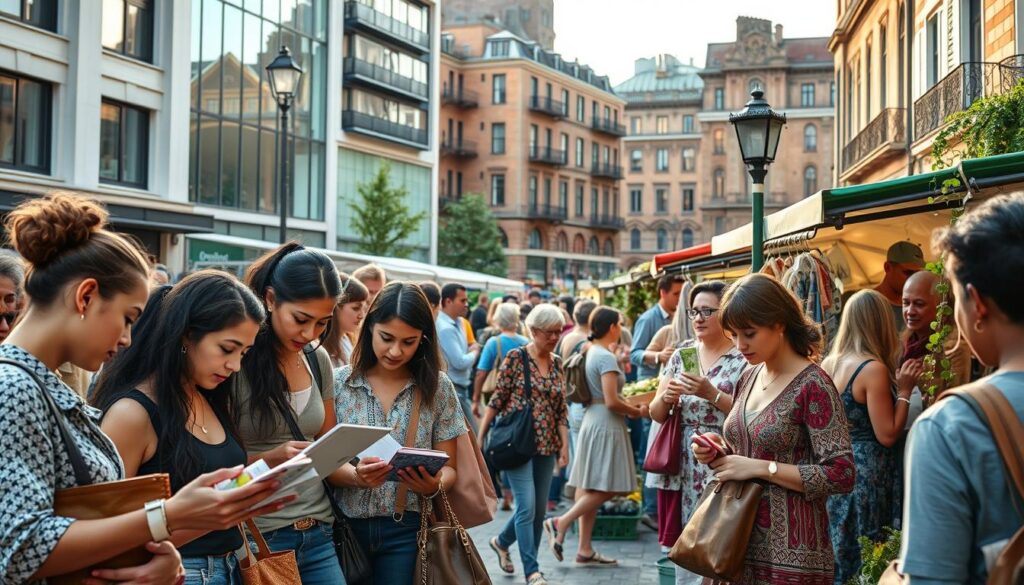Eco-friendly clothing is about changing fashion for the better. It focuses on being kind to the planet and people. By choosing green fashion, we can do good for both Earth and our society. This shift to eco-friendly options shows how important it is to pick clothes that are both cool and kind to nature. We’re going to look at why choosing ethical fashion matters today.
Key Takeaways
- Eco-friendly apparel promotes sustainability and ethical practices in the fashion industry.
- Sustainable fashion offers green clothing options that reduce environmental impact.
- Ethical fashion choices support fair labor practices and community welfare.
- Consumers play a crucial role in the shift towards eco-friendly fashion by making mindful purchases.
- Adopting sustainable fashion is beneficial for both the environment and personal health.
Introduction to Eco-Friendly Apparel
Eco-friendly apparel is more than just a trend. It’s a step toward sustainable and careful fashion choices. This change focuses on sustainable materials and making processes.
These efforts cut down our carbon footprint and save water. They also support fair work conditions. This is key for keeping our environment and society healthy.
Understanding Eco-Friendly Clothing
Eco-friendly clothes use materials that are kind to our planet. This includes organic cotton, recycled plastics, and materials that break down naturally. These are made with less harm to the earth.
Unlike traditional clothes, they don’t use bad chemicals or lots of water. Sustainable fashion thinks about the whole life of clothes. This means from the start to when they’re thrown away, it’s all eco-friendly.
Why Sustainable Fashion Matters
Sustainable fashion is very important. It tackles big environmental and social problems. By using less energy in making clothes, it helps fight climate change.
Eco-friendly practices also use less water. This helps with the problem of not having enough water. Moreover, ethical fashion means workers are treated and paid well. This makes the fashion industry fairer for everyone.
The Environmental Impact of Fast Fashion
Fast fashion has grown a lot recently but brings big environmental issues. Affordable, quick clothes meet demands for new trends. Yet, the environmental costs worry many.
Carbon Emissions and Climate Change
Carbon emissions are a big issue with fast fashion. It uses long chains and energy-heavy processes. This adds a lot to global carbon emissions, speeding up climate change. Making and moving synthetic fibers like polyester also adds a lot to carbon footprints.
Water Consumption and Pollution
Fast fashion also uses and pollutes a lot of water. Making textiles uses tons of water yearly. Using harmful chemicals in dyeing pollutes water badly. This pollution harms people and sea life.
Landfill Waste and Microplastics
The fashion industry makes a lot of landfill waste. Fast fashion leads to throwing away clothes fast. Many clothes can’t break down in landfills. Also, synthetic fabrics are a source of microplastics in fashion. Washing these clothes releases microplastics into water, which ends up in oceans and food.
| Environmental Impact | Details |
|---|---|
| Carbon Emissions | High due to long supply chains and energy-intensive processes. |
| Water Pollution | Contaminated water supplies from hazardous chemicals in dyeing. |
| Landfill Waste | Massive amounts of non-biodegradable textiles. |
| Microplastics | Synthetic fibers releasing microplastics into water systems. |
In summary, fast fashion greatly affects our environment. Issues range from carbon emissions and water pollution to landfill waste and microplastics. Knowing these issues helps us fight for and support greener fashion choices.
Sustainable Fashion Materials
Using sustainable materials in fashion helps our environment. These eco-friendly choices are better than traditional fabrics. They make our planet healthier.
Organic Cotton
Organic cotton is changing sustainable fashion. It grows without harmful chemicals, protecting soil and water. Patagonia uses organic cotton in their clothing. This supports sustainability and quality.
Hemp and Bamboo
Hemp fabric and bamboo textiles are eco-friendly choices. Hemp needs little water and no pesticides. Bamboo grows fast with minimal water, no fertilizers or pesticides.
Hemp and bamboo are strong, breathable, and break down in nature. They create much less CO2. This helps reduce the fashion industry’s environmental footprint.
Recycled Fabrics
Recycled fabrics help manage waste in fashion. By using old plastics and textiles, brands make new items. Allbirds uses recycled fabrics. This reduces landfill waste and saves raw materials.
| Material | Environmental Benefits |
|---|---|
| Organic Cotton | Reduces pesticide use, conserves water |
| Hemp Fabric | Minimal water usage, no pesticides |
| Bamboo Textiles | Fast-growing, needs little water |
| Recycled Fabrics | Conserves resources, reduces landfill waste |
Ethical Fashion: Fair Trade and Labor Practices
Ethical fashion focuses on being good to the planet and people. It makes sure workers get fair pay and safe places to work. The most important parts are fair trade and treating workers right.
Fair Trade Certification
Fair trade means products are made the right way. Brands like People Tree lead in fair trade fashion. They ensure fair treatment and pay for all. Fair trade fights against bad work conditions and unfair treatment.
Ethical Labor Practices in Fashion
Treating workers right is key to changing fashion. This means respecting rights, paying fairly, and providing safe jobs. Brands like People Tree show how fashion can help people in a good way. They offer jobs that respect and treat people fairly.
Adding fair trade and safe jobs will change fashion for the better. Consumers should choose brands that care about doing right. This helps push the fashion world to be more responsible and kind.
Innovative Eco-Friendly Fashion Brands
The fashion world is changing for the better, thanks to amazing sustainable brands. They’re using eco-friendly stuff and being kinder in how things are made. Let’s look at some brands that are really changing the game.
Pioneering Brands in Sustainable Fashion
Some brands are really leading the way in making fashion better for our planet. Patagonia is a great example. They care a lot about our Earth. They use stuff like organic cotton and recycled polyester to lessen harm to our planet.
Stella McCartney is another hero in this movement. Her designs are both fancy and kind to the Earth. She chooses materials like vegan leather and organic fabrics. This shows you can have awesome things without hurting our world.
Brands Using Recycled Materials
Using old materials in new ways is getting popular among cool, sustainable brands. Adidas, for example, makes sporty clothes from recycled ocean plastic. It’s a great way to show how waste can be turned into something awesome.
Girlfriend Collective also does something neat. They make workout clothes from recycled water bottles. This shows how trash can turn into trendy, useful clothes. These efforts show that fashion can be both stylish and good for our Earth.
As people want more eco-friendly stuff, more companies will likely follow these green steps. They’ll use recycled materials and treat people making clothes fairly. This is good for our planet and sets new goals for the future of fashion.
Consumer Role in Promoting Sustainable Fashion
People play a big role in making fashion more eco-friendly. By choosing to shop smart, take good care of their clothes, and recycle or upcycle, they help the planet. This leads to a greener fashion world.
Shopping Mindfully
Shopping with a purpose means picking brands that are kind to the earth. It’s about buying less but choosing better. The eco-friendly fashion market is growing fast. It will be worth a lot by 2031, showing more people want green options.

Caring for Your Clothing
Taking care of your clothes can make them last longer. This means you don’t have to shop as much. Washing in cold water, drying in the air, and using green detergents can help a lot. Europe’s big market for eco-fashion in 2023 shows caring for clothes matters.
Recycling and Upcycling
Treating old clothes in new ways is key. Upcycling fashion and recycling help cut down waste. The Asia-Pacific area is quickly adopting upcycled fashion. This helps reduce trash and shows a big move towards better fashion habits.
Challenges and Solutions in Sustainable Fashion
Sustainable fashion tackles tough issues. High costs and eco-friendly style are big concerns. Yet, these problems lead to creative solutions.
Overcoming Production Costs
High costs are a big hurdle in sustainable fashion. It doesn’t use cheap stuff like fast fashion. Instead, it goes for things that are good for the planet. This makes things pricier.
Brands can cut costs by using recycled stuff and making things more efficiently. Buying sustainable materials in bulk can also help.
Balancing Style and Sustainability
It’s hard to make eco-friendly clothes that are also stylish. Some people think it’s impossible. But brands like Patagonia and Stella McCartney prove it can be done. They use new designs and eco-friendly materials.
“Sustainable fashion isn’t just about buying ‘eco’. It’s about inventiveness, reuse, and creativity,” says Colin Firth.
To make eco-fashion popular, we need new ideas and consumer education. People need to know why it matters. This will make them want more eco-friendly clothes. Then, more brands will get on board.
Future Trends in Sustainable Fashion
The future of sustainable fashion looks very exciting. It’s driven by better sustainable practices and people caring more. One big trend is moving towards circular fashion models. This means recycling, fixing, and reusing clothes to waste less and use resources better.
A big part of eco-friendly fashion is wanting more transparency. People want to know where their clothes come from and how they’re made. This demand is making brands act more sustainably and ethically.
“Transparency is not a choice; it is becoming a necessity in the future of sustainable fashion.”
There’s also a move towards innovative materials. New technology is making sustainable fabrics that look and feel like traditional materials but are much better for the environment. Fabrics from labs and plant-based textiles are getting very popular.
| Trend | Impact | Key Players |
|---|---|---|
| Circular Fashion | Reduces waste and resource consumption | Patagonia, Levi’s |
| Transparency | Builds consumer trust and ethical practices | Eileen Fisher, Everlane |
| Innovative Materials | Lowers environmental footprint | Stella McCartney, Adidas |
The future looks bright for sustainable fashion. With new ideas and better practices, the industry is becoming more ethical and green. These trends will set new standards and inspire more changes towards sustainability in fashion worldwide.
Conclusion
The fashion world is changing to be more green. This is a big change in how we see and buy clothes. Looking at how bad fast fashion is for Earth shows why we need sustainable fashion. This helps cut down harm to our planet and push for better choices.
Being kind to Earth with our fashion choices is not just a passing thing. It is very important for the future of our planet. We talked about better materials like organic cotton and fair work conditions. Brands that lead with these ideas show others how to do better.
Everyone has a role in making fashion better for the world. When we buy smart, take good care of our clothes, and choose green brands, we help a lot. Looking forward, staying green and learning more will make sure fashion cares for our planet and people everywhere.
